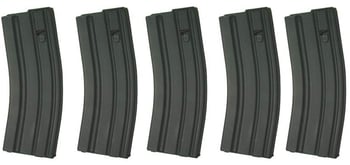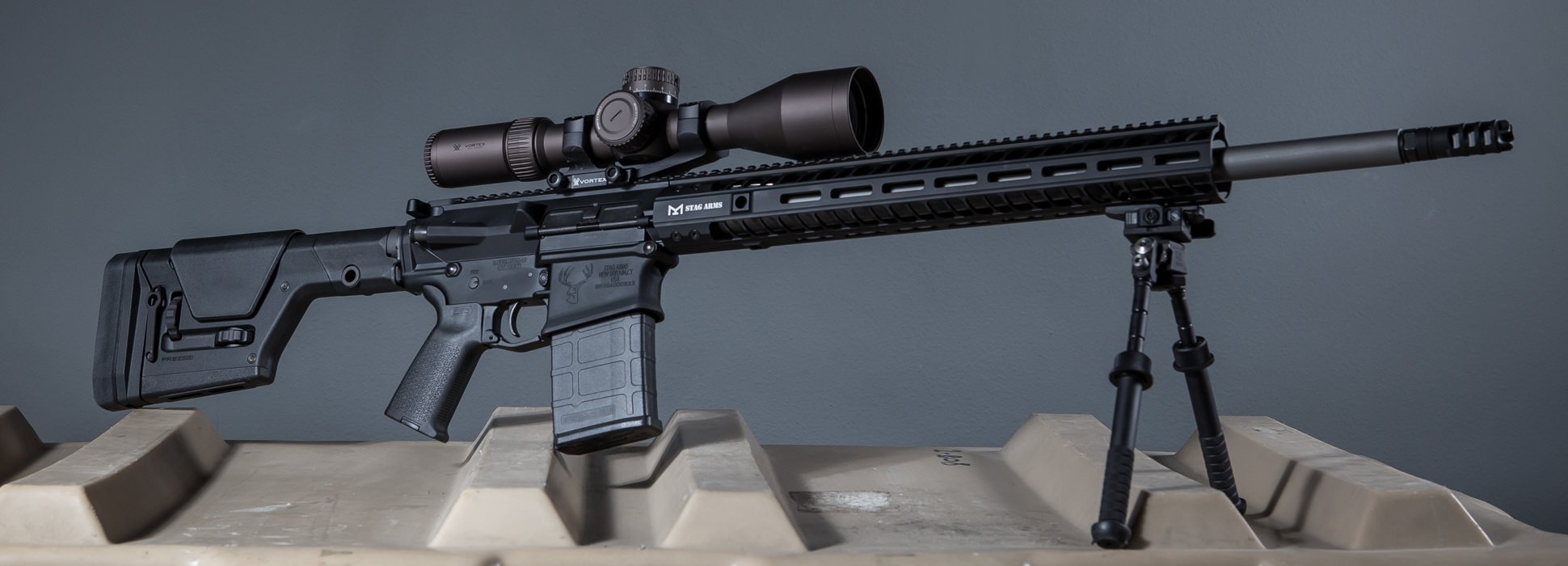 A well-built AR-15 is one of the most reliable semi-auto firearms available. But sometimes even the best rifles may malfunction, and when they do, it is time to diagnose the cause of the malfunction.
A well-built AR-15 is one of the most reliable semi-auto firearms available. But sometimes even the best rifles may malfunction, and when they do, it is time to diagnose the cause of the malfunction.
One of the first components that should be investigated is the magazine.
Magazines get dirty. They vary in quality and dimension from manufacturer to manufacturer. Springs wear out and bodies get bent or broken. Magazines get dropped on the ground and stepped on. Most AR-15 malfunctions are related to lube, ammo, or magazines, or a combination.
We will look at some common magazine issues, and clear up some confusion surrounding terminology.
1.) Hard seating (it is difficult to push the magazine deep enough into the magazine well to allow the magazine catch to engage the magazine).
There are two factors that may be at play here. The first is the design of the firearm. The AR-15 was designed to be loaded with the bolt locked back. If a magazine is inserted when the bolt is closed, the cartridges are forced down against the spring pressure, and the magazine is harder to insert. If the magazine is built to MIL-SPEC dimensions, and fully loaded, the cartridges and follower fully compress the spring when inserted against a closed bolt, and it may be impossible to seat the magazine.
At times it is advantageous to load a magazine with the bolt closed, many shooters download their magazines by one or two rounds to make this easier. Some magazine manufacturers who don't have to adhere to MIL-SPEC standards on the dimensions of a metal magazine make their magazines a little longer, building a magazine capable of accepting 31 rounds, so that it will seat easily with 30. Many people speak about the push-pull method of inserting a magazine. That's fine, but if you are seating a fully loaded MIL-SPEC magazine against a closed bolt, give that thing a firm slap.
The second factor that can cause hard seating is improper dimensions in the rifle or the magazine. If the magazine is hard to seat empty or only partially loaded, this is the cause. In this case, it could be one or more of several dimensions in the rifle or in the magazine that are preventing seating. Look for wear on the magazine feed lips for indications of where the tightness is occurring. At this point, there are three simple options; contact the manufacturer for a replacement, try to modify the magazine to work with the rifle, or find different magazines that will work.
2.) Magazine won't drop free (this means that when the empty magazine is released, it will not fall out of the rifle on its own)
There is a shelf just below the window on the magazine that the magazine catch engages. If the magazine is metal, support the inside of the magazine, and tap that shelf gently with a hammer. Test it in the rifle until it drops free. If it is a polymer magazine, filing the same area will usually work. If the rifle is brand new the magazine catch may be screwed too far into the magazine release button. Try pushing the button all the way in and turning the magazine catch counterclockwise one turn.
3.) Magazine release is hard to push
This is another issue with a simple fix. It usually occurs on new rifles when releasing a fully loaded metal magazine. It is caused but a rough ridge or burr along the top edge if the magazine catch where it contacts the magazine. Push the magazine catch (on the left side of the rifle) out of the receiver from right to left, using a plastic pen tip or a non-marring punch to push the magazine release button, rotate it so that it does not snap back into place, and then smooth the top edge of the magazine release with sandpaper or a fine file. Rotate it back into position and the problem is solved.
4.) Feeding issues due to friction (sharp or rough feed lips)
Metal magazines are stamped out of sheets of aluminum or steel. Because of this process, the inside edge of the feed lips can be sharp or have sharp burrs along it. These will smooth out with use, and aluminum magazines will smooth faster than steel. If you are using a new or nearly new metal magazine, and the bolt is stopping before the cartridge is fully chambered, sharp feed lips may be the cause. Look for noticeable scratches on the case of the cartridge from the feed lips. This problem is usually worse with steel-case ammo than with brass-case ammo, as the steel-case ammo, coated or not, creates more friction in magazines. It is also more noticeable in steel magazines. If you suspect this could be your problem, simply burnish the inside edge of each feed lip lightly with 600 grit emery cloth, or make this your standard practice any time you remove a new metal magazine from its packaging.
5.) Feeding issues due to friction (extra-power springs)
Shooters sometimes use extra-strong aftermarket springs in their magazines even though they are designed to work with the standard springs. The springs may be so stiff that they create enough friction to slow the bolt and cause a malfunction. The solution is to fully load the magazines for a week or two, while also cycling them through the rifle to break in the springs.
6.) Function issues due to improper dimensions or construction
This is harder to diagnose because there is no obvious damage to the magazine - it is still in the shape it was in when it shipped from the factory, but the factory made an error in the magazine's construction. Usually this condition is assumed when it is found that a particular magazine with no damage consistently causes the rifle to malfunction. This can happen with metal or polymer magazines of any brand. The quality of a particular brand's manufacturing process is indicated by how seldom or how often this occurs. Most magazines are not manufactured as precisely as other parts of the rifle, and there are slight variations in dimension from one magazine to the next, even from the same manufacturer. This is the case with aluminum, steel, and polymer magazines. If a particular magazine causes malfunctions in a particular rifle, it should be disposed of or marked and used for training only. If a particular brand of magazines causes malfunctions in a particular rifle, that brand should be avoided with that rifle, no matter how popular or well-regarded the brand is.
7.) Function issues due to damage
Magazines are easily damaged. They are often dropped, stepped on, end up in the bottom of a bag, protrude from the rifle and get banged into things, and just wear out over time.
Some damage is noticeable, some can't be seen, but when a magazine that used to function begins causing malfunctions, damage should be assumed, whether noticeable or not. Damaged magazines should be discarded or clearly marked and used for training only. Damaged magazines can sometimes be repaired by bending, or in the case of polymer, gluing. Repair is not recommended except in an emergency because the materials are weakened and in nearly every case the problem will soon emerge again.
8.) Function issues due to dirty magazines
Magazines get dirty! They gather dust, gravel, leaves, carbon, oil, and brass shavings inside of them with use. Inspect magazines regularly and keep them clean. An old toothbrush and an extra BoreSnake work great. It is generally not recommended to lube the inside of a magazine.
9.) Function issues due to an improperly dimensioned rifle
More often than not, AR-15 function issues can be traced to magazines. Always troubleshoot your magazines before assuming an issue with the rifle. But sometimes, there is an issue with the rifle itself. Different AR-15 manufacturers hold themselves to different manufacturing standards and not all AR-15 rifles are created equal. That super-low price on the budget AR-15 you are considering may be based on money saved through shortcuts in the manufacturing and quality control processes. Quality manufacturers often reject barrels and other parts that do not meet their quality control specifications and rejected parts are sold to budget AR-15 manufacturers and parts suppliers at a discount. The result is a market filled with AR rifles built to varying dimensions. Most magazine manufacturers have compensated by making their magazines a bit undersized so they work in the majority of rifles, but all it takes is one part being out of spec, and your rifle may not function well with most magazines. Improper dimensions in the lower receiver, upper receiver, magazine catch, magazine release button, and bolt carrier can all prevent properly-made magazines from functioning. The $100 savings that is so tempting on that budget AR can soon be offset by frustration and expense as you damage ammunition and buy different magazines in an attempt to get the rifle to function. Keep in mind that any AR-15 rifles or parts that are constantly sold well below normal market prices are probably suspect.
Before diagnosing an issue with your AR-15, make sure the rifle is properly lubed, especially if it is a new rifle. ARs like to run wet, so really lube it well. If the rifle is well lubed, and the malfunction no other obvious cause, the first thing to check is your magazine. More likely than not, that is where the issue will be found.




